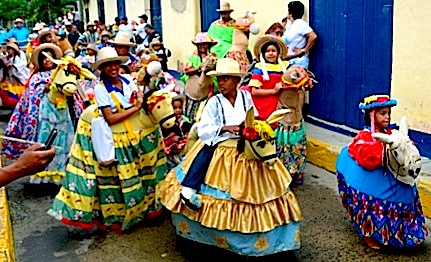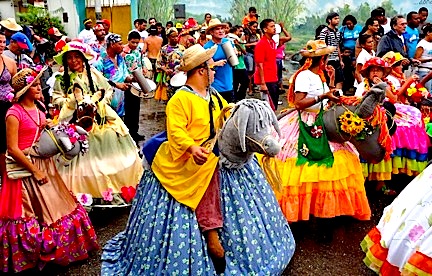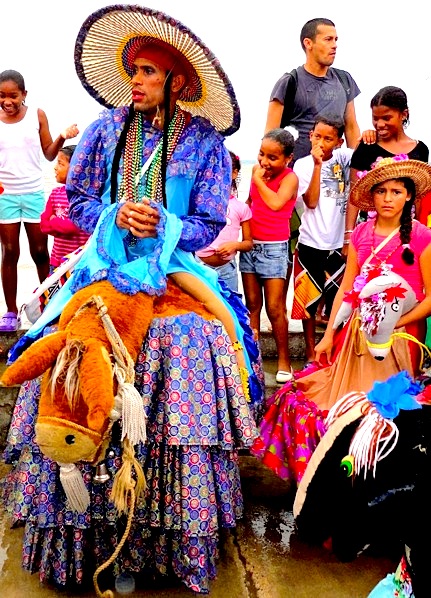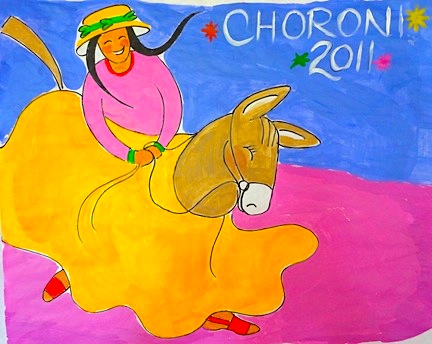| Jan/Feb 2012 • Travel |
| Jan/Feb 2012 • Travel |

The little boy comes running down the mountain road, shouting to anyone who will listen.
"Burriquitas," he sings out. "Las burriquitas vienen."
Of course, we already know this, because Marisol has been working with Maria, Carolina, and Octavio on this festival for weeks. Marisol designed the banners, posters, flyers, and T-shirts. She helped send out the many emails announcing the Second Annual Gathering of Burras and Burriquitas in Choroní. It's been in the papers and on TV.
Burriquitas are a Venezuelan tradition. Men, women, and children handcraft their colorful stuffed donkeys, strap them on, and hit the streets. They dress their animals in bright skirts and put on straw hats with long pigtails, covered in flowers. And because the donkeys' skirts fall to the ground, it appears the people are riding their wildly prancing toy steeds.
The gathering is set for December third to kick off the holiday season, and it's no small event. Burriquitas come from all over the Venezuelan states of Anzoátegui, Apure, Aragua, Barinas, Miranda and Distrito Federal—more than one hundred of them, big and small.

They meet under the banner at the Plaza de Madre Maria, just above our colonial village of Choroní. The skies are heavy with clouds, but that can't dampen their spirits. Two bands with snare drums, bongos, timbales, charrascas, trumpets, saxophones, and trombones strike up a deafening din, as the burriquitas buck and prance their way down through the village to the 300-year-old church of Santa Clara, wind their way around Plaza Bolivar under giant mango trees, then trot through the arch and down the narrow boulevard of La Pantojera. The whole town is out to cheer them on.

Old Miguel Bolivar, whose legs have long since given out, sits in his wheel chair, waiting for the procession, watching as it turns the corner and rushes toward him. The burriquitas shake their rears seductively and surge around him, ready to swallow him up in the festivities.
"It's better than TV," he tells me, as the little stampede sweeps by and gallops on, around the corner and down the side street toward the Posada El Ensueño. The stop here is well timed, because the moment the burriquitas arrive, the heavy rains come down. It's like an ocean wave falling out of the sky, what they call a palo de agua, a stick of water, a tropical downpour so dense it is hard to tell whether the rain is pounding down from the sky or rising up from the ground.
"Mala suerte," the woman from Apure says, looking out at the wall of water. "Bad luck."
"Sí, but good luck that we're all inside," the man from Miranda answers.
Pass the bottle of rum, get out the icy beer. The posada rings with the loud, heavy beat of dueling bands. Everyone is singing and dancing to the cumacos while we wait for the storm to pass. Then it's down the road again, past the thick stands of bamboo, across the yellow bridge over the swollen river and on to El Camping, for another raucous reception and a big lunch under the trees.

The rain comes again, then resolves itself into a drizzle. The streets are pooled with rainwater, sometimes completely flooded. But nobody seems to mind. They dance through it, past Posada Semeruco, Hostal Colonial, Casa Grande, the Cancha de Basketball, and Chucho's fruit stand, by the Licorería San Sebastian, El Gallo's Market and on to the Malecón, where a heavy sea is crashing against the seawall. Someone shoots rockets into the sky to explode over us. A tall, thin man rises above the others, dressed in blue with a great wide sombrero, his animal too big to be called a burriquita.

"Mira esa burra tan grande!" the children shout. "Look at that great big donkey!" The man wears eye shadow, and his lips are rouged. Great strands of shiny colored beads hang down his chest. The children can't resist, drawn by his animal's size. This is the queen of burras. They want to touch her. But she looks so sad. Her head hangs down, almost reaching the ground. Why isn't she smiling and dancing like the rest? One brave little boy puts his hand out to pet her. Then, before he knows what is happening, her head jerks up, her great mouth opens and bites down on his hand. He shrieks and runs, and all his friends scream and run with him. But soon they are back. They can't stay away. The tall rider asks for water and drains a bottle into his thirsty burra's mouth. The children sneak forward, step by cautious step, into a tight ring around her. Suddenly, she turns around, showing them her rear, lifts her tail and sprays them. The kids go nuts. What wild kind of burra is this, that can bite, drink, and piss on us?
The sky is dark now. And still the bands are blaring and still the cartoon donkeys are dancing their whirling, bucking ballet. I think these crazy burriquitas may dance straight through the night.
